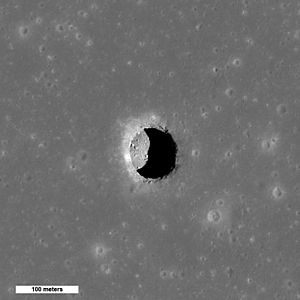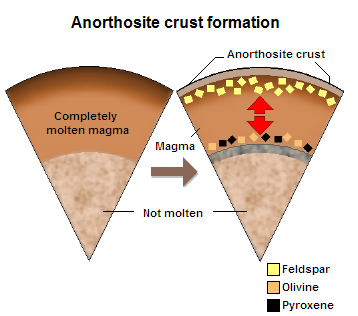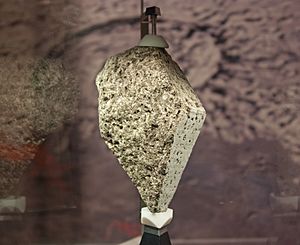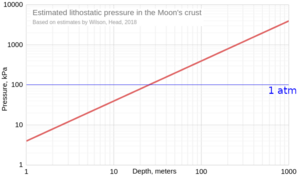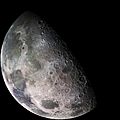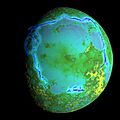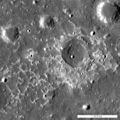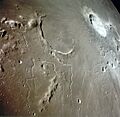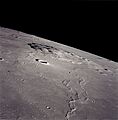Geology of the Moon facts for kids
The geology of the Moon (sometimes called selenology, which is the study of the Moon) is quite different from Earth's geology. The Moon has no real atmosphere, so there's no wind or water to cause erosion. Instead, its surface slowly wears away from tiny meteorites hitting it. The Moon also doesn't have plate tectonics like Earth, and because it's smaller, it cooled down faster.
Besides impacts, the Moon's surface has been shaped by volcanoes. Scientists now think this volcanic activity ended less than 50 million years ago. The Moon has different layers, just like Earth: a crust, a mantle, and a core.
Scientists study the Moon's geology using telescopes from Earth, measurements from spacecraft orbiting the Moon, and samples of lunar rocks. Astronauts from the Apollo program landed on the Moon six times between 1969 and 1972. They brought back about 382 kilograms (842 pounds) of rocks and soil. Robotic spacecraft from the Soviet Union (Luna missions) and China (Chang'e 5) also brought back smaller samples.
The Moon is the only place beyond Earth where we have rock samples from known locations. We've also found some lunar meteorites on Earth, but we don't know exactly where on the Moon they came from. There are still many parts of the Moon that haven't been explored, and many questions about its geology remain unanswered.
Contents
What the Moon is Made Of
Elements found on the Moon's surface include oxygen, silicon, iron, magnesium, calcium, aluminium, manganese, and titanium. Oxygen, iron, and silicon are the most common. Oxygen makes up about 45% of the Moon's weight. Carbon and nitrogen are only found in tiny amounts, brought by the solar wind.
Scientists have also found hydrogen at the Moon's poles. This was discovered using special instruments on the Lunar Prospector spacecraft.
How the Moon Formed
For a long time, scientists wondered how the Moon came to be. Some early ideas included the Moon breaking off from Earth, or being captured by Earth's gravity, or forming at the same time as Earth.
Today, most scientists agree on the giant-impact hypothesis. This idea suggests that a huge object, about the size of Mars, crashed into early Earth. This massive collision sent a lot of material into space, which then came together to form the Moon.
The Moon's History
The Moon's geological history is divided into six main periods, called the lunar geologic timescale.
About 4.5 billion years ago, the Moon was newly formed and very hot, completely melted. It orbited much closer to Earth, and Earth's gravity pulled on it, making it slightly egg-shaped.
The first major event in the Moon's history was the cooling and hardening of this huge ocean of molten rock, called the "magma ocean." We don't know exactly how deep it was, but it might have been 500 kilometers (310 miles) or more.
As the magma ocean cooled, heavier minerals like olivine and pyroxene formed first and sank. Later, lighter minerals like anorthositic plagioclase feldspar formed. Because these were lighter, they floated to the top, creating the Moon's crust, which is about 50 kilometers (31 miles) thick. Most of this magma ocean hardened quickly, within about 100 million years. However, some special magmas, rich in certain elements (called KREEP), might have stayed partly melted for hundreds of millions of years longer. These KREEP-rich magmas ended up mostly in the area of Oceanus Procellarum and the Imbrium basin.
Soon after the crust formed, or even while it was still forming, other types of molten rock started to create different kinds of rocks, like Mg-suite rocks. Scientists are still debating exactly how and where these rocks formed. The oldest of these rocks are about 3.85 billion years old.
Studies of Moon samples suggest that many of the Moon's large impact basins formed in a short period, between about 4 and 3.85 billion years ago. This idea is called the late heavy bombardment. However, scientists now think that some of these impacts might have happened at different times.
The dark plains on the Moon, called maria, are ancient areas covered by huge flows of basaltic lava. These lavas are rich in iron and flow easily. Most of these eruptions happened between 3 and 3.5 billion years ago, but some are as old as 4.2 billion years. Recent studies in the 2010s found evidence of eruptions as recent as 50 million years ago. Along with these lava flows, there were also explosive volcanic eruptions that shot molten rock hundreds of kilometers away. Most of the maria filled low-lying impact basins on the side of the Moon facing Earth.
Today, impacts from meteorites and comets are the only major geological force changing the Moon. Some of the most important craters formed recently. For example, the Copernicus crater, which is 3.76 kilometers (2.3 miles) deep and 93 kilometers (58 miles) wide, is thought to have formed about 900 million years ago. The Apollo 17 mission might have collected samples from the Tycho crater, which could have formed 100 million years ago.
The Moon's surface also experiences "space weathering." This is caused by high-energy particles, solar wind, and tiny meteorite impacts. This process makes the bright rays around young craters darken over time until they blend with the surrounding surface.
After lunar exploration restarted in the 1990s, scientists discovered scarps (steep slopes) all over the Moon. These are caused by the Moon shrinking as it cools down.
Moon's Layers and Time Periods
The Moon's layers of rock and soil, called its stratigraphy, are similar to those on Mercury.
- Copernican unit: This is at the very top. It includes craters with bright "ray systems" (streaks of material shot out during the impact).
- Eratosthenian unit: Below the Copernican unit. These craters have clear shapes but no bright rays.
- Mare units: These are the dark, lava-filled plains.
- Imbrian unit: This layer is related to material thrown out and changes caused by the Imbrium basin impact.
- Pre-Nectarian unit: This is the oldest layer at the bottom, made of old crater plains.
All these layers are also found on Mercury in similar arrangements.
Moon's Landscape
The Moon's landscape is full of impact craters, material thrown out from impacts, a few volcanoes, hills, lava flows, and low areas filled with magma.
Highlands
The most striking thing about the Moon is the difference between its bright and dark areas. The brighter areas are the lunar highlands, called terrae (Latin for "land"). The darker, flat areas are called maria (Latin for "seas"). Johannes Kepler gave them these names in the 17th century.
The highlands are made mostly of anorthosite, a light-colored rock. The maria are made of basalt, a darker rock. The maria are often in low-lying areas, but not all low areas are covered by maria. The highlands are older than the visible maria, so they have many more craters.
Maria
The large dark areas on the Moon, the maria, are the main result of volcanic activity. These are huge flows of basaltic lava that cover almost a third of the Moon's near side (the side we see). Only a small part of the far side has maria. Even before the Apollo missions, most scientists believed the maria were lava-filled plains because they show patterns of lava flows and collapsed areas that look like lava tubes.
Scientists have figured out the ages of the mare basalts using two methods: directly dating the rocks and counting craters on their surfaces. The oldest rocks are about 4.2 billion years old. Most of the younger lavas are about 1 billion years old. However, newer, high-resolution images have found about 70 small areas, called "irregular mare patches," that seem to be sites of much more recent volcanic activity, less than 50 million years ago. Most of the mare formed between 3 and 3.5 billion years ago. The youngest lavas erupted in Oceanus Procellarum, while some of the oldest are on the far side. The maria clearly have fewer craters than the surrounding highlands, showing they are younger.
Many maria erupted into, or flowed into, low-lying impact basins on the Moon's near side. However, the impact events happened much earlier (about 500 million years) than the lava flows that filled them. Also, Oceanus Procellarum, the largest mare area, doesn't match any known impact basin. It's often suggested that the maria are mostly on the near side because the crust there is thinner. But this doesn't fully explain why the far side's South Pole-Aitken basin, which has a thinner crust than Oceanus Procellarum, has only a small amount of mare.
Another type of deposit linked to the maria, though also found in the highlands, are "dark mantle" deposits. These can't be seen with the naked eye but show up in images. Before the Apollo missions, scientists thought these were deposits from explosive volcanic eruptions. Some deposits are connected to dark, cone-shaped hills, supporting this idea. The Apollo missions later confirmed these explosive eruptions by finding tiny glass spheres, similar to those from explosive volcanoes on Earth.
Many lunar basalts have small holes called vesicles. These formed from gas bubbles escaping the magma in the vacuum of space. We don't know for sure which gases escaped, but carbon monoxide is one possibility.
The glass particles from explosive eruptions are green, yellow, and red. The color shows how much titanium the rock has. Green particles have the least titanium (about 1%), and red particles have the most (up to 14%).
Rilles
Rilles are channels on the Moon that sometimes formed from lava flows. They can be winding, curved, or straight. Following these winding rilles often leads to an old volcanic vent. A famous winding rille is Vallis Schröteri. Another example is Rima Hadley, near the Apollo 15 landing site. Scientists now generally believe this rille was formed by volcanic processes.
Domes
Some areas on the Moon, like Mons Rümker, have shield volcanoes. These are thought to have formed from thick, possibly silica-rich lava erupting from specific vents. These "lunar domes" are wide, rounded, circular features with gentle slopes, rising a few hundred meters high. They are usually 8–12 kilometers (5–7.5 miles) wide, but can be up to 20 kilometers (12.4 miles) across. Some domes have a small pit at their top.
Wrinkle Ridges
Wrinkle ridges are features in the maria caused by the Moon's surface being squeezed. These long ridges show where the surface buckled. Some of these ridges might outline buried craters or other features beneath the maria. The crater Letronne is a good example of a feature outlined by a wrinkle ridge.
Grabens
Grabens are geological features that form when the Moon's crust is pulled apart. They consist of two parallel faults with a block of land that has dropped down between them. Most grabens are found within the lunar maria, especially near the edges of large impact basins.
Impact Craters
Scientists only widely accepted that the Moon's craters were formed by impacts in the 1960s. This understanding allowed them to figure out the Moon's impact history. They used the idea of superposition: if one crater (or its ejected material) lies on top of another, it must be younger. The amount of erosion a crater showed also gave clues about its age. In the late 1950s, Gene Shoemaker helped shift the study of the Moon from astronomers to geologists.
Impact cratering is the most important geological process on the Moon. Craters form when a solid object, like an asteroid or comet, crashes into the surface at very high speeds (around 17 kilometers or 10.5 miles per second on average). The energy from the impact creates a shock wave that spreads out. This is followed by a wave that throws most of the material out of the crater. Finally, the crater floor can bounce back up, forming a central peak.
These craters come in all sizes, from tiny pits to the enormous South Pole–Aitken basin, which is almost 2,500 kilometers (1,550 miles) wide and 13 kilometers (8 miles) deep. Generally, the Moon's history shows that larger impact basins formed earlier, and smaller craters formed on top of them later. The number of craters of different sizes on a surface can help estimate its age.
The newest craters have sharp, clear features. Small craters are usually bowl-shaped. Larger impacts can have a central peak and flat floors. Very large craters often have slumped inner walls that form terraces or ledges. The biggest impact basins, called multi-ring basins, can even have several concentric rings of raised material.
Impacts dig up bright material. This makes the new crater, its ejected material, and its "ray system" (streaks of material) look bright. Over time, "space weathering" gradually darkens this material, causing the rays to fade. The crater and its ejected material also get worn down by tiny meteorites and smaller impacts. This erosion makes the crater's features softer and rounder. Craters can also be covered by material ejected from other impacts, which can hide features or even bury the central peak.
Large impacts can throw out huge blocks of material. When these blocks hit the surface again, they form secondary impact craters. These craters sometimes form clear patterns radiating outwards from the main impact. They are usually shallower than primary craters of the same size. Sometimes, a whole line of these blocks can hit, forming a valley. These are different from catena, or crater chains, which are lines of craters formed when an impacting object breaks apart before it hits.
Generally, a lunar crater is roughly circular. Experiments have shown that even impacts at very low angles tend to create circular craters. Elliptical craters only form at impact angles below five degrees. However, a low-angle impact can create a central peak that is not exactly in the middle of the crater. Also, material ejected from angled impacts shows distinct patterns, like an empty wedge-shaped area where the object came from.
Dark-halo craters form when an impact digs up darker material from beneath the surface and then scatters this darker material around the main crater. This can happen when a dark area, like a mare, is covered by lighter material from a distant highland impact. The new impact then digs up the hidden dark material.
The largest impacts produced huge sheets of molten rock, sometimes a kilometer (0.6 miles) thick. You can see examples of this impact melt in the northeastern part of the Mare Orientale impact basin.
Regolith
The Moon's surface has been hit by small and large asteroids and comets for billions of years. Over time, these impacts have crushed and mixed the surface materials, forming a fine, dusty layer called regolith. The regolith is about 2 meters (6.5 feet) thick in the younger maria and up to 20 meters (65 feet) thick in the oldest highland areas. The regolith is mostly made of local materials, but it also contains tiny bits of material thrown out from distant impact craters. The term mega-regolith describes the heavily fractured bedrock directly beneath the surface regolith.
The regolith contains rocks, fragments of minerals from the original bedrock, and glassy particles formed during impacts. In most lunar regolith, half of the particles are made of mineral fragments stuck together by glassy particles; these are called agglutinates. The regolith's chemical makeup changes depending on where it is. In the highlands, it's rich in aluminium and silica, like the rocks there. In the maria, it's rich in iron and magnesium and has less silica, like the basaltic rocks it came from.
The lunar regolith is very important because it also holds clues about the Sun's history. Atoms from the solar wind—mostly hydrogen, helium, neon, carbon, and nitrogen—hit the Moon's surface and get stuck in the mineral grains. By studying the regolith's composition, especially its isotopic makeup, scientists can learn if the Sun's activity has changed over time. The gases from the solar wind could also be useful for future lunar bases. Oxygen, hydrogen (for water), carbon, and nitrogen are not only vital for life but also potentially useful for making fuel.
Lunar Lava Tubes
Lunar lava tubes are seen as important places for building future lunar bases. These bases could be used for exploring the Moon or as outposts for missions beyond the Moon. Scientists have long suggested that lunar lava caves could exist. Any intact lava tube on the Moon could offer shelter from the harsh lunar environment, which includes frequent meteorite impacts, strong ultraviolet radiation, energetic particles, and extreme temperature changes between day and night. After the Lunar Reconnaissance Orbiter was launched, many lunar lava tubes were imaged. These lunar pits are found in several places on the Moon, including Marius Hills, Mare Ingenii, and Mare Tranquillitatis.
Lunar Magma Ocean
The first rocks brought back by Apollo 11 were basalts. Even though the mission landed on Mare Tranquillitatis, a few tiny rock fragments from the highlands were also collected. These were mostly made of plagioclase feldspar, and some were entirely made of anorthite. Finding these mineral fragments led to the idea that a large part of the Moon was once melted. This "magma ocean" then cooled and hardened, forming the crust through a process called fractional crystallization.
The giant-impact hypothesis naturally suggests that the material that came together to form the Moon must have been very hot. Current models predict that a large part of the Moon would have been molten shortly after it formed, with the magma ocean possibly being 500 kilometers (310 miles) deep or even melting the entire Moon. As this magma ocean cooled, it would have created a layered Moon with a distinct crust and mantle, explaining the main types of lunar rocks.
As the lunar magma ocean cooled, minerals like olivine and pyroxene would have formed and sunk to create the lunar mantle. After about three-quarters of the magma had cooled, anorthositic plagioclase would have started to form. Because it was light, it would have floated to the top, forming the anorthositic crust. Importantly, elements that don't easily mix into solid minerals would have become more and more concentrated in the remaining liquid magma as it cooled. This would have formed a KREEP-rich magma that was initially trapped between the crust and mantle. Evidence for this idea comes from the very anorthositic makeup of the lunar highland crust, as well as the existence of KREEP-rich materials. Also, studies of zircon from Apollo 14 samples suggest the lunar crust formed about 4.51 billion years ago.
Lunar Rocks
The Apollo program brought back about 380 kilograms (838 pounds) of lunar surface material. Most of this is stored at the Lunar Receiving Laboratory in Houston, Texas. The robotic Soviet Luna programme also returned about 326 grams (11.5 ounces) of lunar material. These rocks have been incredibly helpful in understanding how the Moon's geology changed over time. Lunar rocks are mostly made of the same common rock-forming minerals found on Earth, such as olivine, pyroxene, and plagioclase feldspar (anorthosite). Plagioclase feldspar is mostly found in the lunar crust, while pyroxene and olivine are usually found in the lunar mantle. The mineral ilmenite is very common in some mare basalts. A new mineral called armalcolite (named after the Apollo 11 crew: Armstrong, Aldrin, and Collins) was first discovered in lunar samples.
The maria are mainly made of basalt. The highland regions, however, have little iron and are mostly made of anorthosite, a rock primarily composed of calcium-rich plagioclase feldspar. Another important part of the crust are igneous "Mg-suite" rocks, like troctolites, norites, and KREEP-basalts. These rocks are thought to be related to the formation of KREEP.
Mixed rocks on the Moon's surface often appear as breccias. These are rocks made of broken fragments of other rocks cemented together. They are categorized based on how they formed, such as fragmental, granulitic, and impact-melt breccias. The mafic (rich in magnesium and iron) impact melt breccias have more iron and magnesium than typical upper crust anorthositic rocks, as well as higher amounts of KREEP.
Composition of the Maria
The main difference between the basaltic rocks of the maria and the rocks of the lunar highlands is that basalts have more olivine and pyroxene and less plagioclase. They are richer in iron than Earth's basalts and flow more easily. Some of them have high amounts of an iron-titanium oxide called ilmenite. Because the first rock samples had a lot of ilmenite, they were called "high titanium" basalts. The Apollo 12 mission brought back basalts with less titanium, called "low titanium" basalts. Later missions, including Soviet robotic probes, found basalts with even lower concentrations, now called "very low titanium" basalts. The Clementine spacecraft showed that mare basalts have a continuous range of titanium concentrations, with the highest concentration rocks being the least common.
Inside the Moon
Scientists have created the current model of the Moon's interior using seismometers (instruments that detect ground motion) left behind during the Apollo missions. They also studied the Moon's gravity field and how it rotates.
The Moon's mass is enough to suggest there are no empty spaces inside it; it's thought to be solid rock throughout. Its low overall density (about 3346 kilograms per cubic meter) means it doesn't have much metal. Its mass and how it spins suggest the Moon likely has an iron core that is less than about 450 kilometers (280 miles) in radius. Studies of the Moon's small wobbles as it rotates also show that the core is still molten (liquid). Most planets and moons have iron cores that are about half the size of the body. The Moon is unusual because its core is only about one-quarter of its radius.
The Moon's crust is about 50 kilometers (31 miles) thick on average, though this can vary. Scientists estimate that the far-side crust is about 15 kilometers (9 miles) thicker than the near side. Seismology has only measured the crust's thickness near the Apollo 12 and Apollo 14 landing sites. Early analyses suggested a crustal thickness of about 60 kilometers (37 miles) at these sites, but more recent studies suggest it's thinner, between 30 and 45 kilometers (18.6 and 28 miles).
Magnetic Field
The Moon has a very weak external magnetic field compared to Earth's. Another big difference is that the Moon doesn't have a magnetic field like Earth's, which is created by a "geodynamo" in its core. The magnetic fields present on the Moon are almost entirely found in its crust. One idea is that these crustal magnetic fields formed early in the Moon's history when a geodynamo was still active. However, the Moon's small core size makes this idea challenging. Another possibility is that on airless bodies like the Moon, temporary magnetic fields could be created during impact events. Supporting this, the strongest crustal magnetic fields seem to be located opposite the largest impact basins.
Even though the Moon doesn't have a magnetic field like Earth's, some of the returned rocks do have strong magnetic properties. Also, measurements from orbit show that some parts of the Moon's surface have strong magnetic fields.
Images for kids
-
False-color image of the Moon taken by the Galileo orbiter showing geological features. NASA photo
-
Ancient rift valleys – rectangular structure (visible – topography – GRAIL gravity gradients) (October 1, 2014)
-
Ancient rift valleys – context
-
Ancient rift valleys – closeup (artist's concept)
See also
 In Spanish: Geología de la Luna para niños
In Spanish: Geología de la Luna para niños
- Lunar geologic timescale
- Lunar resources
- Selenography
- Transient lunar phenomenon




